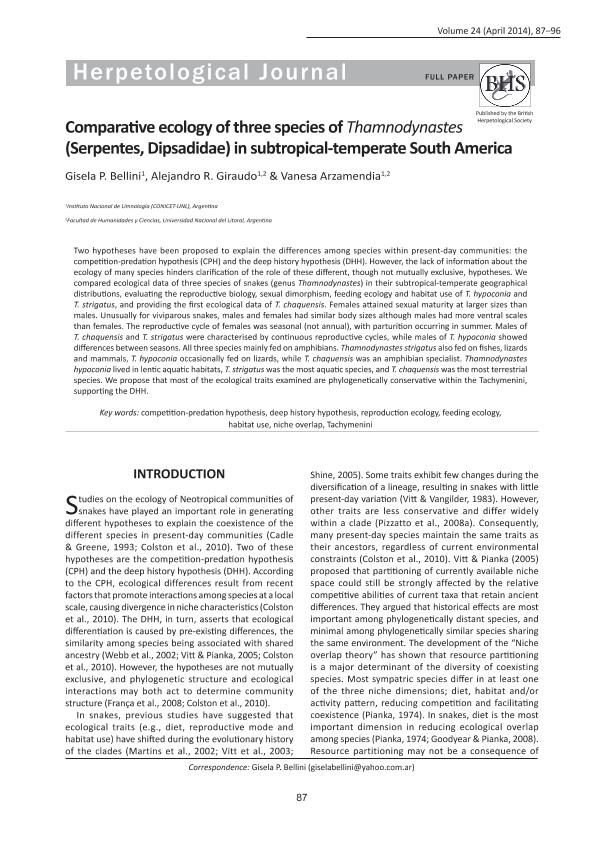Mostrar el registro sencillo del ítem
dc.contributor.author
Bellini, Gisela Paola

dc.contributor.author
Giraudo, Alejandro Raul

dc.contributor.author
Arzamendia, Vanesa

dc.date.available
2017-12-27T18:08:56Z
dc.date.issued
2014-04
dc.identifier.citation
Arzamendia, Vanesa; Giraudo, Alejandro Raul; Bellini, Gisela Paola; Comparative ecology of three species of Thamnodynastes (Serpentes, Dipsadidae) in subtropical-temperate South America; British Herpetological Society; Herpetological Journal; 24; 2; 4-2014; 87-96
dc.identifier.issn
0268-0130
dc.identifier.uri
http://hdl.handle.net/11336/31676
dc.description.abstract
Two hypotheses have been proposed to explain the differences among species within present-day communities: the competition-predation hypothesis (CPH) and the deep history hypothesis (DHH). However, the lack of information about the ecology of many species hinders clarification of the role of these different, though not mutually exclusive, hypotheses. We compared ecological data of three species of snakes (genus Thamnodynastes) in their subtropical-temperate geographical distributions, evaluating the reproductive biology, sexual dimorphism, feeding ecology and habitat use of T. hypoconia and T. strigatus, and providing the first ecological data of T. chaquensis. Females attained sexual maturity at larger sizes than males. Unusually for viviparous snakes, males and females had similar body sizes although males had more ventral scales than females. The reproductive cycle of females was seasonal (not annual), with parturition occurring in summer. Males of T. chaquensis and T. strigatus were characterised by continuous reproductive cycles, while males of T. hypoconia showed differences between seasons. All three species mainly fed on amphibians. Thamnodynastes strigatus also fed on fishes, lizards and mammals, T. hypoconia occasionally fed on lizards, while T. chaquensis was an amphibian specialist. Thamnodynastes hypoconia lived in lentic aquatic habitats, T. strigatus was the most aquatic species, and T. chaquensis was the most terrestrial species. We propose that most of the ecological traits examined are phylogenetically conservative within the Tachymenini, supporting the DHH.
dc.format
application/pdf
dc.language.iso
eng
dc.publisher
British Herpetological Society

dc.rights
info:eu-repo/semantics/openAccess
dc.rights.uri
https://creativecommons.org/licenses/by-nc-sa/2.5/ar/
dc.subject
Competition-Predation Hypothesis
dc.subject
Deep History Hypothesis
dc.subject
Reproduction Ecology
dc.subject
Feeding Ecology
dc.subject
Niche Overlap
dc.subject
Tachymenini
dc.subject
Habitat Use
dc.subject.classification
Otras Ciencias Biológicas

dc.subject.classification
Ciencias Biológicas

dc.subject.classification
CIENCIAS NATURALES Y EXACTAS

dc.title
Comparative ecology of three species of Thamnodynastes (Serpentes, Dipsadidae) in subtropical-temperate South America
dc.type
info:eu-repo/semantics/article
dc.type
info:ar-repo/semantics/artículo
dc.type
info:eu-repo/semantics/publishedVersion
dc.date.updated
2017-12-26T19:50:47Z
dc.journal.volume
24
dc.journal.number
2
dc.journal.pagination
87-96
dc.journal.pais
Reino Unido

dc.journal.ciudad
Montrose
dc.description.fil
Fil: Bellini, Gisela Paola. Consejo Nacional de Investigaciones Científicas y Técnicas. Centro Científico Tecnológico Conicet - Santa Fe. Instituto Nacional de Limnología. Universidad Nacional del Litoral. Instituto Nacional de Limnología; Argentina
dc.description.fil
Fil: Giraudo, Alejandro Raul. Consejo Nacional de Investigaciones Científicas y Técnicas. Centro Científico Tecnológico Conicet - Santa Fe. Instituto Nacional de Limnología. Universidad Nacional del Litoral. Instituto Nacional de Limnología; Argentina. Universidad Nacional del Litoral. Facultad de Humanidades y Ciencias; Argentina
dc.description.fil
Fil: Arzamendia, Vanesa. Consejo Nacional de Investigaciones Científicas y Técnicas. Centro Científico Tecnológico Conicet - Santa Fe. Instituto Nacional de Limnología. Universidad Nacional del Litoral. Instituto Nacional de Limnología; Argentina. Universidad Nacional del Litoral. Facultad de Humanidades y Ciencias; Argentina
dc.journal.title
Herpetological Journal

dc.relation.alternativeid
info:eu-repo/semantics/altIdentifier/url/https://www.thebhs.org/publications/the-herpetological-journal/volume-24-number-2-april-2014/739-03-comparative-ecology-of-three-species-of-i-thamnodynastes-i-serpentes-dipsadidae-in-subtropical-temperate-south-america?format=html
Archivos asociados
